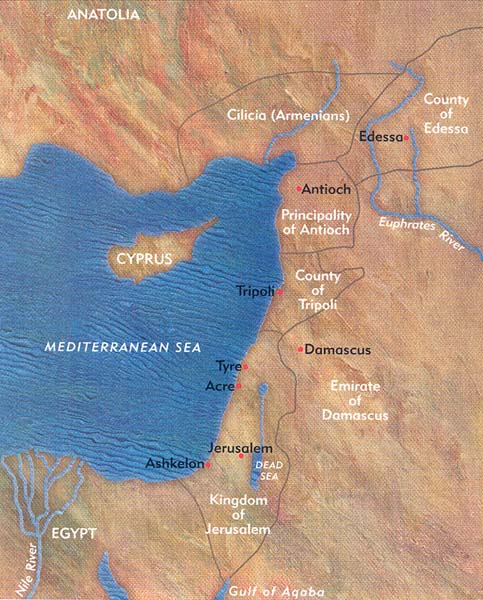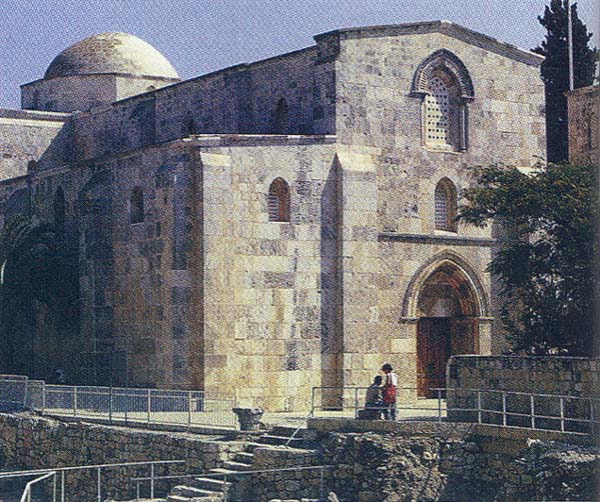When Crusader Kings Ruled Jerusalem
020


It was one of the most romantic, chaotic, cruel, passionate, bizarre and dramatic episodes in history. In the 12th and 13th centuries A.D., a continual stream of European armies, mustered mostly in present-day France and Germany, marched out to destroy the infidel. Crusaders attacked non-Christians in northern and eastern Europe; they conducted bloody pogroms against Jews and “heretical” Christians in their own territories; they campaigned to push Muslims off the Iberian peninsula and out of North Africa; and, most important of all, they conquered Palestine, ruling the Holy Land from their citadel (above) in Jerusalem.
Easily the most successful of these campaigns was the First Crusade (1096–1099). Palestine had been in Muslim hands since the seventh century, when Persians and then Arabs wrested it from the Christian Byzantine Empire. In the mid-11th century, Seljuk Turks from beyond the Caspian Sea invaded the Near East, converted to Islam and subdued the reigning Arab power, the Abbasid caliphate in Baghdad. They then pressed north and west, seizing most of Byzantine Anatolia. The Seljuk advance meant that Christian influence in the East was considerably diminished. It also meant that pilgrimage routes, long protected by the Byzantines and friendly Arab rulers, were closed down: Christians could no longer walk where Jesus had walked.
The Byzantine emperor Alexius I appealed to the West for help. In 1095 Pope Urban II responded; in a speech delivered at Clermont, in central France, he called for a crusade to save the Christian East from 021Islam. Seljuk Turks, Urban reportedly said, were disemboweling Christians and dumping the bloody viscera on church altars and baptismal fonts. Those who joined this crusade, or “took the cross,” the pope announced, would have their sins absolved, for God himself desired that Christianity recover Jerusalem.
The First Crusade, like most of the later ones, was led by European noble and royal families, who raised funds and armies from their estates. (Even the official, pope-sponsored crusades, however, were joined by ragtag groups of women, children, paupers, priests and elderly penitents.) One army, for example, was led by three brothers with possessions in Lorraine—Eustace, Baldwin and Godfrey; Godfrey and Baldwin would become the first rulers of the Latin Kingdom of Jerusalem. Other Crusaders were the king of France’s brother, Hugh of Vermandois, and William the Conqueror’s son, Robert of Normandy. A Norman family that had settled in southern Italy sent Tancred, who was the first to lead Crusader troops into Jerusalem and onto the Temple Mount.
These armies marched overland to Constantinople, where Emperor Alexius I ferried them across the Bosphorus into Asia. They then crossed Anatolia and laid siege to Antioch, which fell in 1098—becoming the first crusader colony in the Near East.
Most of the Crusader forces continued south, facing little resistance as they moved down the Levantine coast. On July 15, 1099, after a two-week siege of Jerusalem, Tancred broke through the city’s northern wall, near Herod’s Gate. The city’s Muslim rulers surrendered without a fight. The next morning, 022however, Jerusalem became a killing field as the conquerors slaughtered nearly every Muslim in the city and burned down a synagogue in which Jews had sought refuge. “With drawn swords our men ran through the city not sparing anyone, even those begging for mercy,” wrote Fulcher of Chartres, who served as Baldwin’s chaplain. “They desired that this place, so long contaminated by the superstition of the pagan inhabitants, should be cleansed from their contagion.”
The Crusaders elected Godfrey as their first leader. Upon Godfrey’s death in 1100, they named his brother Baldwin as the first king of the Latin Kingdom of Jerusalem (which, in its brief tenure, would have four more kings named Baldwin). In the following decades, the new Crusader kingdom secured the main coastal cities of the Levant: Caesarea (1101), Haifa and Acre (1104), Beirut and Sidon (1110), and Tyre (1124). King Baldwin I (1100–1118) took territories in the Transjordan and built a series of fortresses from the Dead Sea to the Gulf of Aqaba. King Baldwin III (1152–1163) captured Ashkelon from the Egyptian Fatimid dynasty, which was using the city’s port to conduct raids against the Crusader kingdom. By the mid-12th century, the Latin Kingdom of Jerusalem controlled the territories of present-day Israel, western Jordan and southern Lebanon. In addition, the Crusaders had set up states in Edessa, Antioch and Tripoli. The entire Levant was now a European colony.
On the holy city of Jerusalem itself, the Crusaders left little mark. At first, their activities were concentrated on the Temple Mount (see “The Holiest Ground in the World”). From indigenous Near Eastern 023Christians, the Crusaders learned that the Temple Mount was associated with such biblical events as the presentation of Christ in the Temple (Luke 2:22–38) and Jacob’s dream of a ladder to heaven (Genesis 28:11–17). The Crusaders immediately converted the Muslim Dome of the Rock—which, they were told, rested on the site of the Jewish Temple mentioned in the Gospels—into a Christian church, which they called the Templum Domini. They later covered the massive rock inside the building (see photo of Templum Domini in “The Holiest Ground in the World”) with elaborate marble casing, to serve as an altar; they also filled the building’s niches with sacred carvings, erected an intricate iron grille around the building’s inner octagon, and placed an iron cross on top of the dome.
Crusader kings first took up residence in the Al-Aqsa Mosque, on the southern end of the Temple Mount; but in 1118 they abandoned the mosque for the newly rebuilt citadel, south of the Tower of David. Al-Aqsa then became the residence of the Templar Knights—an order first created to protect pilgrim routes and later transformed into an elite fighting force.

Outside the Temple Mount, the Crusaders built a covered market, a new city gate (Tanners’ Gate), a hospital (run by the Knights of the Order of St. John, also known as the Hospitallers, who, like the Templars, were first founded to care for pilgrims but later became a military force) and various other buildings.

What the Crusaders really built, however, were churches, a number of which still survive in excellent condition. East of the city, on the Mount of Olives, they built the Church of the Tomb of the Virgin over an earlier Byzantine structure, which, according to tradition, contained the tomb of Mary. In this church the Crusaders placed the tomb of Queen Melisende (1131–1152), the daughter of Baldwin II. Just north of the northeast corner of the Temple Mount, they erected the splendid Romanesque Church of St. Anne (above). The Crusaders’ most enduring architectural legacy, however, is their rebuilding of the Church of the Holy Sepulchre (see photo of Church of the Holy Sepulchre in “The Holiest Ground in the World”), on the foundations of the fourth-century A.D. church built by Constantine, supposedly over Jesus’ tomb.
Crusader rule in Jerusalem lasted a mere 90 years. In 1187 the sultan Saladin, who had unified Egyptian and Syrian territories into the Abbasid caliphate, defeated the army of the Latin Kingdom of Jerusalem at the Horns of Hattin, west of the Sea of Galilee, and took control of Jerusalem. For two brief periods in the 13th century, between 1229 and 1244, Crusaders regained control of Jerusalem—but only by treaty with the Muslim Ayyubids (a new caliphate formed by Saladin’s successors), who refused to allow Christians to visit the sacred Temple Mount.
After Saladin’s conquest, the Latin kings ruled from the coastal cities of Tyre and Acre, not from Jerusalem. Their holdings consisted of a thin strip along the Mediterranean, which expanded during Crusades (altogether there were seven official crusades in the 12th and 13th centuries, along with countless smaller ones) and contracted as the Crusaders returned home. In the late 13th century, a new force arose in Egypt, the Mamluks, a class of fierce slave warriors who wrested power from the Ayyubids. The Mamluk sultan Baybars campaigned up the Levantine coast, regaining Crusader possessions. The last Crusader outpost, the city of Acre, fell in 1291, putting an end to the European presence in Palestine.
It was one of the most romantic, chaotic, cruel, passionate, bizarre and dramatic episodes in history. In the 12th and 13th centuries A.D., a continual stream of European armies, mustered mostly in present-day France and Germany, marched out to destroy the infidel. Crusaders attacked non-Christians in northern and eastern Europe; they conducted bloody pogroms against Jews and “heretical” Christians in their own territories; they campaigned to push Muslims off the Iberian peninsula and out of North Africa; and, most important of all, they conquered Palestine, ruling the Holy Land from their citadel (above) in Jerusalem. Easily the most successful […]
You have already read your free article for this month. Please join the BAS Library or become an All Access member of BAS to gain full access to this article and so much more.
Already a library member? Log in here.
Institution user? Log in with your IP address or Username
